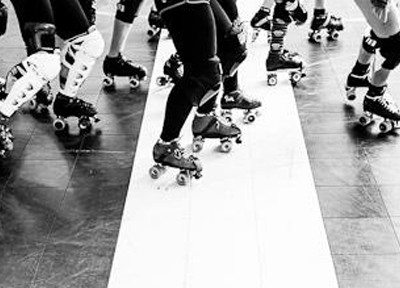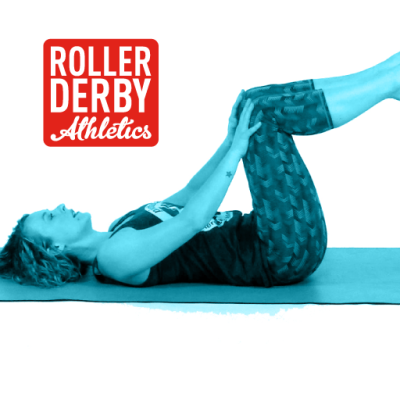
Most of us have experienced this before: the dreaded penalty spiral. We feel hopeless and useless as we’re making our way back to the penalty box over and over. No one ever starts off a game in hopes of receiving multiple penalties in a row, but sometimes we find ourselves setting up shop in the penalty box. No matter what competitive level you play at or how many years of experience you have, we can all be subjected to these downward spirals. The good news is that if we change our mindset, we can avoid the spiral towards fouling out.
All it comes down to is refocusing. You don’t want a penalty to distract you from playing at your optimal level. It’s important to know that it’s not the penalty itself that gets us into trouble, it’s how we REACT to the penalty that can change the entire situation. This Mental Muscle post is all changing your perspective on your penalties to keep you focus on your game!
A Look Back on Focus
Focus is your ability to concentrate on certain key elements in your environment. In the Focus Funnel post, I broke down the four dimensions of focus:
- Narrow focus
- Broad focus
- Internal focus
- External focus
All four dimensions are needed to gain a better sense of what is happening around you, to internalize a plan of action, to execute a block or juke in a specific moment, and to adjust your plan depending on external cues such as a penalty or score. You cannot successfully compete by using only one dimension of Focus. Therefore whenever your focus shifts onto one single element of the game (e.g. penalty, score, negative thought) that element can become a distraction.
If you know that penalties are your gateway to becoming distracted, then you know you need to control your focus. This is where refocusing plans come into place. A refocusing plan is a routine; every time you are faced with a penalty, you will need to implement this routine.
Today I’m sharing my very own 30 Second Penalty Routine with you! If it works for me, it might just work for you too…
30 Second Penalty Routine
This is a penalty routine that I have taught a few roller derby athletes over the past year. The purpose of the routine is to help athletes stay focussed on their game and not get distracted with additional thoughts and feelings that surround their penalties. And guess what? It only takes four easy steps:
Step 1 – Acknowledge your Penalty
If you start disagreeing with the referee’s call, then you are already developing a conflict in your mind. Roller derby is already complex, don’t make it harder on yourself. Your actions got you in the box, so own up to your actions. A simple nod or telling yourself, “yup, that was a penalty,” is already one step away from going down a spiral. Take responsibility for your actions.
Step 2 – Reflect on your Penalty
It’s one thing to acknowledge a penalty, but it’s another to understand why you received it: what actions got you in the box? Ask yourself: what adjustments do you need to make to your game? This puts the control back into your hands. Learn from that penalty in order to better your game, instead of letting it defeat you.
You’re competing in a roller derby game, so you don’t have the luxury of reflecting for a very long time. Being stuck in the past for too long can be a distraction to your overall focus. This is why I tell athletes that they need to reflect from the moment they receive the penalty to the moment they sit in the box.
Example: After I acknowledged that I received a direction of game play penalty for a clockwise block, I would reflect on WHY: “I was too focused on hitting the jammer out of bounds”. Then WHAT I need to do to adjust my game: “Next time I will be more patient. Focus on pinning the jammer to the line before I hit.” A simple reflect and adjust can be done within a matter of seconds, but with practice your reaction to reflect and adjust will become quicker.
Step 3 – Ten Second Reset
As soon as your butt hits that chair, it’s time to relax and reset. Now that you’re in the box, you need to move from the past (reflecting on the penalty) to the present. Think of resetting like cleaning the slate dry. You know how to readjust your game, now it’s time to let go of the penalty.
There are multiple ways of resetting, and the most common ways are based around relaxation techniques, which allow you to remove any unwanted emotions that might be creeping up. Below you can find three suggestions, which you can use individually or combined: whatever works for you.
Breathing
- By controlling your breathing to a slow rhythm, you can decrease your heart rate and energy levels. Slow and controlled breathing also increases oxygen to the blood and relaxes your muscles.
- Close your eyes. Breath in slowly for 4 seconds and then breath out slowly for 4 seconds. You’re breathing in calmness/control and breathing out the penalty/frustration.
Imagery
- You can relax by picturing an mental image that induces relaxing feelings. As soon as you sit in the box, sit back to get comfortable. Close your eyes and visualize see your mental image.
Verbal Cue
- Just as images can be used to relax your mind and body, verbal cues can be used to remind yourself to breathe or relax. Just like with the Imagery technique, sit back to get comfortable when you arrive in the box. Then you are say a word or statement to yourself that will remind you to relax. For example, “I feel calm.”
Step 4 – Focus on the Jam
Now that you are relaxed, it’s time to refocus yourself to the present moment. More importantly, you need to prepare yourself to re-enter the game. The best way to force your mind to think about what is happening on the track is talking about what you are seeing/going to do. It’s impossible for your brain to talk about one thing and think about another (neat trick, right?). So the simple act of talking to yourself will force your brain to think about that topic. That being said, you are not acting like a commentator. Instead, describe to yourself what you would do in that situation: e.g. “I would be doing offense, hitting the blocker on the outside”. When you are released from the box, you are already engaged and invested with the jam. You will be more prepared in returning to the track. It will also take away from thinking about your past penalty or worrying that you will get another.
Just like any refocusing plan, practice will make it more of a routine response. So even if you get a penalty at a practice scrimmage, try applying this plan as much as possible. Another great way to practice this routine it so watch game footage of yourself. When you get a penalty try applying these steps as you are watching yourself heading to and sitting in the box.
Four simple steps: acknowledge, reflect, relax, and refocus. These steps can help you get back on track of having a great performance!
Do you have any other tricks you’ve been using to re-set yourself mentally when you get a penalty? Let me know in the comments below!
-Jess Bandit

 Prehab! Feet and Ankles
Prehab! Feet and Ankles  Stop sucking. Start winning.
Stop sucking. Start winning.  Pre-Hab: How to Engage Your Core
Pre-Hab: How to Engage Your Core  How to Improve at Derby’s 27 Laps Test
How to Improve at Derby’s 27 Laps Test  The Top Ten Exercises for Roller Derby Athletes
The Top Ten Exercises for Roller Derby Athletes